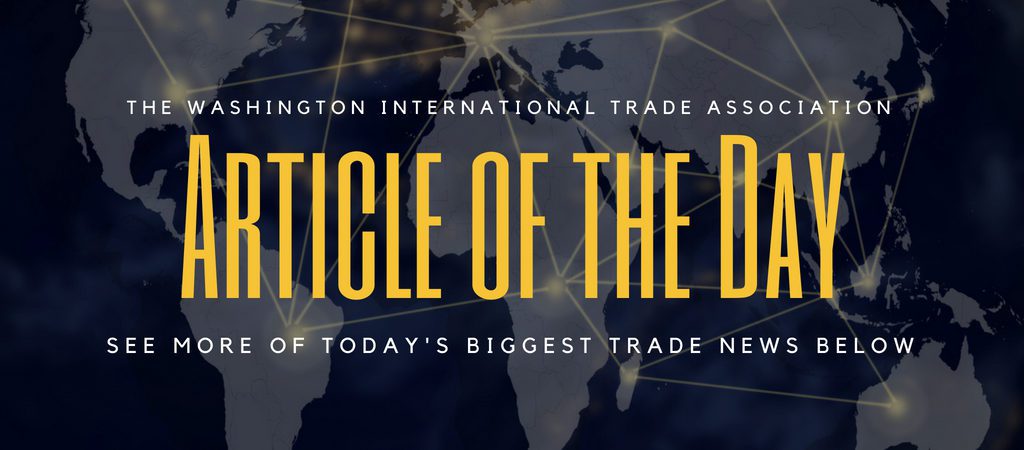-
Trump officials want to raise America’s bound WTO tariffs
-
USTR says there are no plans to raise WTO rates ‘at this time’
The U.S. is weighing a plan to increase its long-standing ceiling on tariffs in a move meant to trigger a renegotiation of relationships with fellow World Trade Organization members and step up its assault on the global trading system.
President Donald Trump and senior aides have long complained about the fact that other countries can charge higher tariffs on certain products than the U.S. does. They cite examples such as steeper European passenger-car duties and Indian motorcycle tariffs as evidence of the way they believe global trading rules are tilted against America.
But in what would be the boldest move yet to attack that perceived problem, U.S. Trade Representative Robert Lighthizer is now mulling a plan to reset American tariff commitments at the WTO by threatening to increase the tariff ceilings — or bound rates — agreed to by previous administrations over decades of negotiations, according to people familiar with the discussions.
The potential move follows Trump’s signing of a partial agreement with China last month that is seen by critics as a major step away from the rules-based order policed by the WTO. The Trump administration has managed to paralyze the Geneva-based institution’s dispute system by blocking the appointment of judges to its appellate body.
The new discussions, though, are part of a broader effort under way inside the administration to look at other ways it could shake up the global system and address their view that its core — the WTO — is rotten.
In a statement, the U.S. Trade Representative’s office said there aren’t any plans “at this time” to increase the WTO tariff cap.
“The administration has expressed numerous times that we are very troubled that many of our trading partners have tariffs that are much higher than the United States’, but there are no plans at this time to raise our bound tariff levels at the WTO,” a USTR spokesman said.
WTO Tariff Ceilings
The U.S. complains its main trading partners have higher bound rates, but according to people familiar with the discussions, the administration’s strategy is to start with a proposal to renegotiate America’s WTO tariffs with the expectations that the WTO’s other 163 members would not collectively agree to new multilateral terms.
If and when WTO talks fail, the Trump administration would then consider moving forward unilaterally to impose reciprocal tariffs on America’s trade partners, the sources told Bloomberg.
Such an approach would be “completely unworkable,” said Rufus Yerxa, the president of the Washington-based National Foreign Trade Council.
“You can’t have pure reciprocity with each country unless you set out different tariffs for each product,” Yerxa told Bloomberg in a phone interview. “That would be a mess. It would undermine predictability for U.S. businesses and make us a global pariah.”
The U.S.’ average bound rate is now 3.4% although it can be far higher on individual products and the Trump administration has used loopholes in global trading rules to impose punitive 25% tariffs on imports of steel and various products from China.
Lengthy Process
The Trump administration has long said that the U.S. is treated unfairly by other nations because it’s bound by higher tariffs and its trading partners are unwilling to lower theirs. In Davos, Switzerland, last month Trump said he had discussed a “very dramatic” change with WTO Director-General Roberto Azevedo. “We’re talking about a whole new structure for the deal or we’ll have to do something,” Trump said without elaborating.
U.S. concerns over tariff mismatches have been part of the conversation between Lighthizer and Azevedo for some time, according to people familiar with the matter. Azevedo met again with Lighthizer on Tuesday in Washington in a previously unreported visit, they said.
At 3.4%, the average bound tariff rate charged by the U.S. is among the lowest for major developed countries and has remained virtually unchanged for more than a decade. By comparison, the average bound rates for India are 51% and Brazil’s are 31%.
A renegotiation could help the White House increase its pressure on various nations and trading blocs with whom the U.S. does not have an existing free-trade agreement, like the European Union, the U.K., India and Brazil. Washington is trying to restart stalled negotiations with the Brussels aimed at removing industrial tariffs and avoiding an escalation of tensions that’s led to threats of tariffs and retaliation.
To see the full article, click here.

